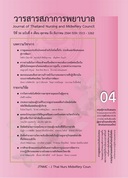Factors Predicting Acute Kidney Injury Among Critically lll Older Patients After Non-Cardiac Surgery
Keywords:
acute kidney injury, critical ill older patient, after non-cardiac surgery, Roy adaptation modelAbstract
Objective: To examine the predictive power of preoperative hemoglobin, the revised cardiac risk index, peri-operative erythrocyte transfusion, and time of operation toward acute kidney injury among critically ill older patients after non-cardiac surgery.
Design: Retrospective predictive correlational design with cross-sectional study
Methodology: The researcher recruited a total sample of 278 older patients who met the criteria, aged 60 years and over, received any major surgeries except cardiac surgery and were admitted to Intensive Care Unit after surgery. Data were analyzed using descriptive statistics and binary logistic regression. Roy adaptation model was employed as a conceptual framework for explaining physiologic adaptation.
Results: Most of samples were females with an average age of 74.77 years (SD=8.35).An occurrence of post-operative acute kidney injury was 50%. The predictive power analysis results illustrated that pre-operative hemoglobin, revised cardiac risk indexes, received peri-operative erythrocyte transfusion and time of operation could jointly predict acute kidney injury with explained variance of 52.4% (Nagelkerke R2=.524). The findings also revealed that pre-operative hemoglobin indicating anemia, revised cardiac risk indexes at high risk, peri-operative erythrocyte transfusion more than 500 ml., less than or equals to 500 ml., and time of operation equal or more than 120 minutes could put the critically ill older patients after non-cardiac surgery at risk of acute kidney injury for 3.779, 8.819, 7.154, 2.141 and 3.560 times, respectively.
Recommendation: The study findings could be utilized as a clinical information for planning nursing care of critically ill older patients undergoing non-cardiac surgeries at ICU admission describing physiologic adaptation by Roy adaptation model. In addition, nurses should closely monitor acute kidney injury because they are at high risk, especially ones with high revised cardiac risk indexes and peri-operative erythrocyte transfusion more than 500 ml.
Downloads
References
Long TE, Helgason D, Helgadottir S, Palsson R, Gudbjartsson T, Sigurdsson GH, et al. Acute kidney injury after abdominal surgery: incidence, risk factors, and outcome. Anesth Analg. 2016;122(6):1912-20. doi: 10.1213/ANE.0000000000001323.
Poolaireab P, Danaidutsadeekul S, Charuangvanich W, Kongsayreepong S. The relationships among comorbidity, intraoperative conditions, systemic inflammatory response syndrome, and acute kidney injury of critical patients in frst 72 hours after major surgery. Thai Journal of Nursing Council. 2016; 34(1):107-17. (in Thai)
Teixeira C, Rosa R, Rodrigues N, Mendes I, Peixoto L, Dias S, et al. Acute kidney injury after major abdominal surgery: a retrospective cohort analysis. Crit Care Res Pract. 2014; 2014:132175. doi: 10.1155/2014/132175.
Linton AD, Metteson MA. Medical-surgical nursing. 7th ed. St. Louis, MO: Elsevier; 2020.
Meiner SE, Yeagar JJ. Gerontologic nursing. 6th ed. St. Louis, MO: Elsevier; 2019.
Huether SE, McCance KL, Brashers VL. Understanding pathophysiology. 7th ed. St. Louis, MO: Elsevier; 2020.
Kim CS, Oak CY, Kim HY, Kang YU, Choi JS, Bae EH, et al. Incidence, predictive factors, and clinical outcomes of acute kidney injury after gastric surgery for gastric cancer. PLoS One. 2013;8(12):e82289. doi: 10.1371/journal.pone.0082289.
Biteker M, Dayan A, Tekksein Ai, Can MM, Taycı I, Ilhan E, et al. Incidence, risk factors, and outcomes of perioperative acute kidney injury in non-cardiac and nonvascular surgery. Am J Surg. 2014; 207(1):53-9. doi: 10.1016/j.amjsurg.2013. 04.006.
Kidney Disease Improving Global Outcomes Acute Kidney Injury Work Group. KDIGO clinical practice guidelines for acute kidney injury. Kidney Int Suppl. 2012;2(1):1-138. doi:10.1038/ kisup. 2012.2.
Luo X, Jiang L, Du B, Wen Y, Wang M, Xi X, et al. A comparison of different diagnostic criteria of acute kidney injury in critically ill patients. Crit Care. 2014;18(4):R144. doi:10. 1186/cc13977.
Williams P. Basic geriatric nursing. 7th ed. St. Louis, MO: Elsevier/ Mosby; 2020.
Sanford AM, Morley JE. Anemia of old age. J Nutr Health Aging. 2019;23(7):602-5. doi:10. 1007/ s12603-019-1214-x.
Tomozawa A, Ishikawa S, Shiota N, Cholvisudhi P, Makita K. Perioperative risk factors for acute kidney injury after liver resection surgery: a historical cohort study. Can J Anaesth. 2015;62:753-61. doi: 10. 1007/s12630-015-0397-9.
Dedinská I, Mikolajčík P, Skálová P, Mokáň M, Laca Ľ. Acute kidney injury after liver resection in elderly
patients. BMC Nephrol. 2019;20(1):272-81. doi: 10.1186/s12882-019-1449-0.
Roy C, Bakan G, Li Z, Nguyen TH. Coping measurement: creating short form of Coping and Adaptation Processing Scale using item response theory and patients dealing with chronic and acute health conditions. Appl Nurs Res. 2016;32(1):73-9. doi: 10.1016/j.apnr.2016. 06. 002.
Suyasith P, Chayaput P, Thosingha O, Sirikun J. Comparison of clinical factors in adult, young older, and older trauma patients. Thai Journal of Nursing Council. 2021;36(1):110-28. (in Thai)
Roy C. The Roy adaptation model. 3rd ed. Upper Saddle River, NJ: Pearson; 2009.
Rangaswami J, Bhalla V, Blair JEA, Chang TI, Costa S, Lentine KL, et al. Cardio-renal syndrome: Classifcation, pathophysiology, diagnosis, and treatment strategies: a scientifc statement from the American Heart Association. J Am Heart Assoc. 2019;139(16):840-78. doi: 10.1161/CIR. 0000000000000664.
Zarbock A, Koyner JL, Hoste EAJ, Kellum JA. Update on perioperative acute kidney injury. Anesth Analg.
;127(5):1236-45. doi: 10.1213/ANE.000 0000000003741.
Raji YR, Ajayi SO, Ademola AF, Lawal TA, Ayandipo OO, Adigun T, et al. Acute kidney injury among adult
patients undergoing major surgery in a tertiary hospital in Nigeria. Clin Kidney J. 2018;11(4):443-9. doi:
1093/ckj/sfx144.
Chayaput P, Utriyaprasit K, Bootcheewan S, Thosingha O. Coping and health problems of caregivers of
survivors with traumatic brain injury. Aquichan. 2014;14(2):170-83. 22. Peduzzi P, Concato J, Kemper E, Holford TR, Feinstein AR. A simulation study of the number of events per variable in logistic regression analysis. J Clin Epidemiol. 1996:49(12):1373-9. doi: 10.1016/s0895-4356 (96)00236-3.
Grove SK, Gray JR. Understanding nursing research: building an evidence-based practice. 7th ed. St. Louis,
MO: Elsevier Saunders; 2019.








